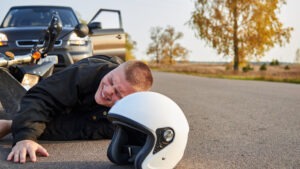
Motorcyclists often find themselves navigating through a landscape where the margin for error is slim, and the consequences of others’ mistakes can be severe. Among the myriad challenges they face, four common hazards stand out due to their frequent role in accidents: driver error, poor road conditions, bad weather, and gravel.
When motorcyclists fall victim to accidents caused by these hazards, primarily due to another driver’s fault, they should be aware that they have the right to pursue compensation for their losses. A motorcycle accident lawyer in Atlanta can review your case and explain your legal options for recovery.
The Most Common Hazards a Motorcyclist Might Encounter on the Road
The following is a list of the most common hazards a motorcyclist might encounter, along with explanations of why they should be avoided. Hopefully, this list can help educate motorcyclists on potential dangers and encourage safer riding practices.
Limited Visibility to Other Drivers
Driver error is the number one cause of motorcycle accidents. Due to their smaller size, other drivers may have more difficulty seeing motorcyclists, especially in a vehicle’s blind spots, at night, or during adverse weather conditions, increasing the risk of collisions.
Intersections
Many accidents occur at intersections where vehicles may inadvertently fail to yield, not see the motorcyclist, or misjudge the motorcycle’s speed, leading to collisions.
Vehicles Speeding or Driving Recklessly
Other vehicles operating at high speeds or with reckless behavior can create unsafe conditions for motorcyclists, who have less protection in the event of an accident.
Following Distances
Insufficient following distances by other vehicles can lead to situations where motorcyclists are at a higher risk of being hit from behind, especially if traffic stops abruptly.
Impaired Drivers
Drivers under the influence of alcohol or drugs pose a significant risk to motorcyclists, as their impaired judgment and reaction times can lead to dangerous or fatal accidents.
Poor Road Conditions
Hazards such as potholes, gravel, debris, and uneven surfaces can unexpectedly affect a motorcycle’s stability. Even grass clippings can pose a danger. These conditions are particularly dangerous for motorcycles due to their smaller size and limited stability compared to cars.
Inclement Weather
Rain, snow, ice, and high winds can make it difficult for all vehicles to navigate safely. For motorcycles, these conditions not only reduce visibility but also significantly decrease tire traction, making it hard to maintain control.
Risks in Heavy Traffic
Congested traffic conditions can lead to situations where motorcycles might be overlooked or have reduced space to maneuver, heightening the risk of being rear-ended or involved in collisions during lane changes.
Stationary Objects on the Roadside
Barriers, signs, and parked vehicles can become hazards if a motorcyclist needs to make sudden maneuvers to avoid other vehicles or objects on the road.
Animal Crossings
Animals entering the roadway can create dangerous situations for motorcyclists, who may have limited options to swerve safely or stop in time to avoid a collision. And lacking the protection a car affords, the impact can lead to catastrophic injuries.
Railroad Crossings and Trolley Tracks
These can pose unique challenges for motorcyclists, where the rails may cause tires to slip or get caught, particularly when they are wet, leading to potential loss of control.
For a free legal consultation, call 404-214-2001
How a Motorcyclist Can Avoid These Hazards
To enhance safety and mitigate the risks associated with the hazards mentioned, motorcyclists can take several proactive steps. Here’s a bullet list of recommendations for motorcyclists to help avoid these hazards:
Adhere to Speed Limits
Always obey speed limits and adjust your speed according to road, traffic, and weather conditions. Riding at appropriate speeds gives you more time to react to unexpected hazards and reduces the likelihood of losing control of your motorcycle.
Stay Visible
Use reflective material on your bike and gear, keep your headlights on day and night, and position yourself in the lane where you are most visible to other drivers, especially at intersections and in heavy traffic.
Maintain a Safe Following Distance
Keep a safe distance from the vehicle in front of you to allow ample time to react and stop safely, especially in poor road conditions or heavy traffic.
Ride Defensively
Assume that other drivers may not see you or anticipate your actions. Be prepared to take evasive action by staying alert and constantly scanning the road for hazards.
Wear Proper Gear
Always wear protective gear, including a DOT-approved helmet, high-visibility clothing, gloves, and appropriate footwear. This gear can significantly reduce the risk of injury in case of an accident.
Use Turn Signals and Hand Signals
Make your intentions clear to other drivers by using both turn signals and hand signals when changing lanes or turning.
Avoid Riding in Bad Weather
Whenever possible, avoid riding in inclement weather. If caught in bad weather, reduce your speed, increase your following distance, and take breaks to avoid fatigue.
Take a Motorcycle Safety Course
Enroll in a motorcycle safety course to learn advanced riding techniques, such as evasive maneuvering and safe braking practices.
Regularly Inspect Your Motorcycle
Before each ride, check your motorcycle’s tire pressure, brakes, lights, and fluid levels to ensure everything is in working order.
Plan Your Route
Avoid roads known for poor conditions or heavy traffic when possible. Use GPS or map apps to plan routes with safer roads and less congestion.
Be Cautious at Intersections
Slow down as you approach intersections, cover your brakes, and look both ways, even if you have the right of way.
Watch for Animals
Especially during dawn and dusk when animals are more active, slow down in rural areas and use high beam headlights at night to spot animals more easily.
Practice Riding on Different Surfaces
Familiarize yourself with how your motorcycle handles on various surfaces like wet roads, gravel, or over railroad tracks, so you’re prepared for these conditions on regular rides.
By adopting these practices, motorcyclists can significantly reduce their risk of accidents and ensure a safer riding experience.
Call Kaine Law Today About Your Motorcycle Accident Injury
If you’ve experienced a motorcycle accident due to another’s negligence, it’s crucial to understand your rights and options. To begin with, the statute of limitations for personal injury claims, O.C.G.A. § 9-3-33, is two years, so time is of the essence.
Kaine Law offers free consultations to evaluate your case and guide you through filing a motorcycle accident injury claim. Our personal injury lawyers work on contingency, meaning you won’t pay any fees unless we secure a settlement or win your case. Don’t navigate this challenging time alone; let the legal team at Kaine Law advocate for the compensation you deserve. Call us today to discuss your situation and how we can help.
Call or text 404-214-2001 or complete a Free Case Evaluation form



